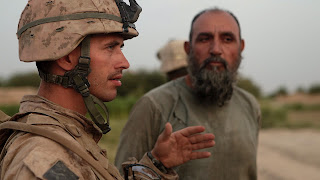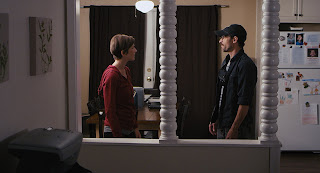DVD Review - Hell and Back Again
Nominated for the Academy Award for Best Documentary, this movie should win the Oscar more for its technical achievement than its actual content. We don't learn anything more here than what we learned, even by inference, in The Hurt Locker. This movie is supposed to immerse us in the mind of its protagonist, a U.S. marine named Sergeant Nathan Harris, which it does to some extent, but director Danfung Dennis leaves out a ton of information.
Danfung Dennis is a war photographer. He's been taking pictures of the Iraq and Afghanistan wars since 2006. His work has appeared in Newsweek, Time, The New York Times, The Washington Post, The Guardian and Rolling Stone. Dennis wanted to expand beyond still photographs and transition into narrative filmmaking. He experimented until he developed a customized camera rig to help him make that transition.
Hell and Back Again is the first feature film to be shot entirely with a highly customized Canon 5D Mark II digital SLR camera rig. Subsequently, Rubber (2010) was shot using this camera and the upcoming Act of Valor (2012) was also filmed using this camera. The Canon 5D Mark II is primarily a stills camera, which can be used to shoot video but that's not its main function. Dennis converted it to be able to shoot video in cinema quality and capture good audio on the go. He had great results, but it was not without its difficulty.
Dennis was embedded with various units in Afghanistan in 2009. He learned of a major offensive taking place in the Helmand River Valley, so Dennis joined the U.S. Marines of Echo Company, 2nd Battalion, 8th Regiment. The soldiers were dropped into the area and immediately started taking fire. The fighting was focused in a location nicknamed Machine Gun Hill.
In the wake of the battle, Sgt. Harris offered Dennis a bottle of water and thus started their friendship. Six months later, Harris gets shot in the hip, nearly bleeds to death, has multiple surgeries and returns home to North Carolina and his wife, Ashley. Dennis follows Harris and stays with him as Harris undergoes recovery.
Dennis edits the movie, cutting back-and-forth between the six month tour in Afghanistan and Harris' recovery in North Carolina. Dennis doesn't have narration. His interviews provide us with few facts. He merely follows Harris from place-to-place and just observes. In fact, the information I related in the previous two paragraphs is information that Dennis doesn't. I gathered all of that instead from the movie's press kit. Dennis provides extremely little context.
Harris is a compelling character whom Dennis was right to follow. We do empathize with Harris, during some moments, literally feeling his pain, his physical pain and frustration. Aside from the emotional suffering though, Dennis doesn't really plum any depths or make as firm a connection to anything as Tim Hetherington and Sebastian Junger did in Restrepo. The sound design, though minimal, is superb.
Two Stars out of Five.
Not Rated But Recommended for Mature Audiences.
Running Time: 1 hr. and 28 mins.
Danfung Dennis is a war photographer. He's been taking pictures of the Iraq and Afghanistan wars since 2006. His work has appeared in Newsweek, Time, The New York Times, The Washington Post, The Guardian and Rolling Stone. Dennis wanted to expand beyond still photographs and transition into narrative filmmaking. He experimented until he developed a customized camera rig to help him make that transition.
Hell and Back Again is the first feature film to be shot entirely with a highly customized Canon 5D Mark II digital SLR camera rig. Subsequently, Rubber (2010) was shot using this camera and the upcoming Act of Valor (2012) was also filmed using this camera. The Canon 5D Mark II is primarily a stills camera, which can be used to shoot video but that's not its main function. Dennis converted it to be able to shoot video in cinema quality and capture good audio on the go. He had great results, but it was not without its difficulty.
Dennis was embedded with various units in Afghanistan in 2009. He learned of a major offensive taking place in the Helmand River Valley, so Dennis joined the U.S. Marines of Echo Company, 2nd Battalion, 8th Regiment. The soldiers were dropped into the area and immediately started taking fire. The fighting was focused in a location nicknamed Machine Gun Hill.
In the wake of the battle, Sgt. Harris offered Dennis a bottle of water and thus started their friendship. Six months later, Harris gets shot in the hip, nearly bleeds to death, has multiple surgeries and returns home to North Carolina and his wife, Ashley. Dennis follows Harris and stays with him as Harris undergoes recovery.
Dennis edits the movie, cutting back-and-forth between the six month tour in Afghanistan and Harris' recovery in North Carolina. Dennis doesn't have narration. His interviews provide us with few facts. He merely follows Harris from place-to-place and just observes. In fact, the information I related in the previous two paragraphs is information that Dennis doesn't. I gathered all of that instead from the movie's press kit. Dennis provides extremely little context.
Harris is a compelling character whom Dennis was right to follow. We do empathize with Harris, during some moments, literally feeling his pain, his physical pain and frustration. Aside from the emotional suffering though, Dennis doesn't really plum any depths or make as firm a connection to anything as Tim Hetherington and Sebastian Junger did in Restrepo. The sound design, though minimal, is superb.
Two Stars out of Five.
Not Rated But Recommended for Mature Audiences.
Running Time: 1 hr. and 28 mins.











Comments
Post a Comment